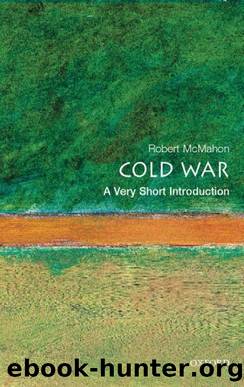The Cold War: a very short introduction by Robert J. McMahon

Author:Robert J. McMahon [McMahon, Robert J.]
Language: eng
Format: epub
Tags: General, History - General History, History, Modern, 20th century, United States, Political Science, Politics & government, International Relations, Arms Control, International Relations - General, History: World & General, General & world history, Modern - 20th Century, Foreign relations, World history: postwar; from c 1945 -, 1945-1989, Cold War., Cold War, History: American, Soviet Union - Foreign relations - United States, World politics - 1945-, United States - Foreign relations - Soviet Union., Postwar 20th century history; from c 1945 to c 2000, World politics - 1945-1989, Nuclear Age, United States - Foreign relations - Soviet Union, 1945-, World politics, Soviet Union
ISBN: 9780192801784
Publisher: Oxford University Press
Published: 2003-02-15T05:00:00+00:00
ar
d W
7. Photographic evidence of a medium-range ballistic missile site at San Cristobal, Cuba, October 1962.
e Col
Th
hemisphere. He subsequently ordered a renewed covert campaign to sabotage and subvert the Castro government, while the CIA, with White House approval, launched a series of ever more bizarre plans to assassinate Cubaâs âMaximum Leaderâ. It is difficult to dispute Castroâs retrospective observation that: âIf the United States had not been bent on liquidating the Cuban revolution, there would not have been an October crisis.â
The October crisis, or the Cuban Missile Crisis as it is more commonly known, constitutes the most dangerous SovietâAmerican confrontation of the entire Cold War, the one in which the two superpowers â and the world â came closest to the devastation of nuclear war. The crisis broke on 14 October 1962, when a U-2 reconnaissance plane photographed some intermediate-range missile sites under construction in Cuba. Two days later, the intelligence community presented the president with 90
incontrovertible photographic evidence that the Soviet Union had placed missiles in Cuba. Those images offered an alarming picture: Cuba had already received between 16 and 32 missiles from the Soviet Union, both Intermediate Range Ballistic Missiles (IRBMs), with a striking range of 2,200 miles, and Medium Range Ballistic Missiles (MRBMs), with a striking range of 1,020 miles. The CIA estimated that the missiles would probably be operational within a week and, once mounted with nuclear warheads, be capable of inflicting as many as 80 million casualties if launched against major US cities. Judging this startling development an exceedingly grave threat to US security, Kennedy constituted an Executive Committee, or ExCom, of his National Security Council to provide him with advice and build a consensus behind the agonizing F
decisions he knew he would soon have to make. The president and rom c
his inner circle were agreed, from the first, about the absolute onfrontation t
unacceptability of nuclear missiles in Cuba and hence upon the need for their prompt removal. The most daunting question, and the one upon which the virtually round-the-clock meetings of the o
ExCom pivoted, concerned what means could most reliably be det
ent
employed to achieve that end â without triggering a nuclear e
conflict.
, 1958â68
Why had Khrushchev rolled the dice in so blatantly provocative a manner? Available evidence now suggests that, in May 1962, the Soviet premier decided upon the risky gambit of deploying nuclear missiles to Cuba for several reinforcing reasons. He sought, first of all, to deter a US invasion of Cuba, thereby affording protection to a regime that had cast its lot with the Soviet Union. By so doing, he could also deflect the challenge posed by an increasingly hostile China and reclaim the Kremlinâs historic position as the military and ideological fountainhead of the worldâs socialist revolutionary forces. Additionally, and perhaps most importantly, Khrushchev saw in the beleaguered Cuban revolution a fortuitous opportunity to close the wide missile gap between the Soviet Union and the United States. âThe Americans had surrounded our country with military bases and threatened us with nuclear weapons,
Download
This site does not store any files on its server. We only index and link to content provided by other sites. Please contact the content providers to delete copyright contents if any and email us, we'll remove relevant links or contents immediately.
| Africa | Americas |
| Arctic & Antarctica | Asia |
| Australia & Oceania | Europe |
| Middle East | Russia |
| United States | World |
| Ancient Civilizations | Military |
| Historical Study & Educational Resources |
Machine Learning at Scale with H2O by Gregory Keys | David Whiting(4186)
Never by Ken Follett(3795)
Fairy Tale by Stephen King(3220)
The Man Who Died Twice by Richard Osman(2997)
Oathbringer (The Stormlight Archive, Book 3) by Brandon Sanderson(2888)
Will by Will Smith(2794)
Rationality by Steven Pinker(2291)
The Dark Hours by Michael Connelly(2246)
Can't Hurt Me: Master Your Mind and Defy the Odds - Clean Edition by David Goggins(2228)
The Dawn of Everything: A New History of Humanity by David Graeber & David Wengrow(2122)
Friends, Lovers, and the Big Terrible Thing by Matthew Perry(2120)
Principles for Dealing With the Changing World Order: Why Nations Succeed and Fail by Ray Dalio(1974)
HBR's 10 Must Reads 2022 by Harvard Business Review(1778)
A Short History of War by Jeremy Black(1763)
Go Tell the Bees That I Am Gone by Diana Gabaldon(1687)
515945210 by Unknown(1600)
A Game of Thrones (The Illustrated Edition) by George R. R. Martin(1591)
Kingdom of Ash by Maas Sarah J(1529)
443319537 by Unknown(1470)
